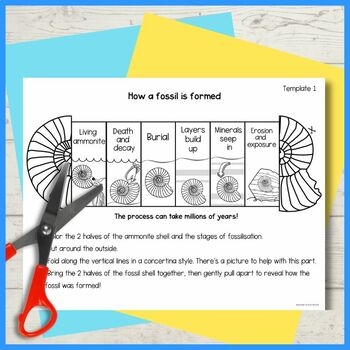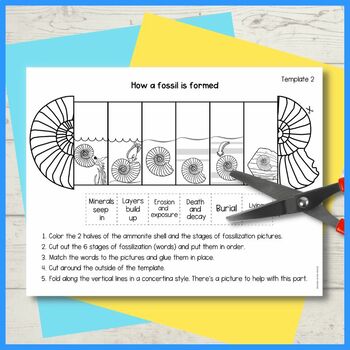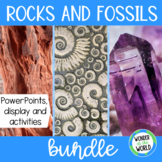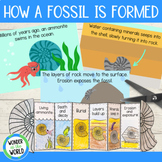How a fossil is formed foldable sequencing activity fossilization process
- Zip
What educators are saying
Also included in
- This bundle of resources is packed full of information about rocks and fossils including a rocks display, fossil activities, and PowerPoints. Ideal to support an elementary geology or earth science unit. Resource 1 - Rocks Classroom Display8 rock example photos (granite, chalk, sandstone, flint, marPrice $10.00Original Price $17.50Save $7.50
- Excite and engage your students with facts and information about fossils with this activity and presentation bundle. This earth science set of resources covers how fossils are formed, what they can tell us, fossil examples, and more!Resource 1 - A-Z Rocks and Fossils Google Slides presentation ConsoPrice $8.25Original Price $14.50Save $6.25
- Teach or review the stages of how fossils form with these ammonite fossil activities. There are 2 resources in this mini-bundle - a set of illustrated cards showing how an ammonite became a fossil and a foldable activity. A bonus word search freebie is also included. How a fossil is formed foldablePrice $3.60Original Price $5.50Save $1.90
Description
Teach or review the stages of how fossils form with this folding ammonite cut-and-paste activity. This foldable sequencing activity will help students recall 6 stages of fossilization in a fun and engaging way, that's more hands-on than a standard fossils worksheet.
Ammonites were pre-historic sea creatures with tentacles and a spiral shell. Their fossils can be found all over the world in many different types of sedimentary rock.
The templates
There are 4 similar PDF templates to choose from for this foldout activity:
1. Color the images, cut out and fold.
2. Color the images, cut out the words and sequence them, glue the words in place, cut and fold.
3. Color the images, cut out the words with the pictures and sequence them, glue the words in place, cut and fold.
4. Larger version of template 3 (over 2 pages).
When closed, you'll just see the large fossil ammonite but when opened, the fossilization process will be revealed! You can see a finished example in the preview. This activity is ideal to use as a science center, for an interactive science notebook or for an earth science lesson on fossil formation.
Instructions for students are provided (including a picture showing how to fold) as well as some questions for a whole class discussion. Some suggested answers are provided for this.
US and UK paper sizes and spelling included. This resource is not editable.
What teachers are saying:
⭐⭐⭐⭐⭐'This is a perfect culminating activity for our fossils unit. Very relevant and engaging.
⭐⭐⭐⭐⭐'This activity was SO MUCH FUN! My students LOVED it!'
⭐⭐⭐⭐⭐'What a wonderful little craft for learning how fossils are made! I love that this didn’t involve an hour’s worth of coloring. One of my favorite things we’ve made yet!'
⭐⭐⭐⭐⭐'I used this resource when planning my fossils unit during my year long clinical experience in college. I planned that whole unit and the steps that a fossil forms based on this resource'.
***Keep up to date with brand new resources by following my store***








